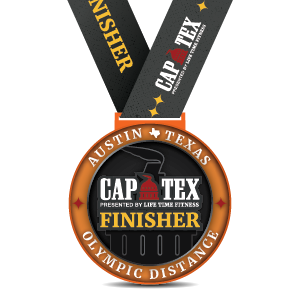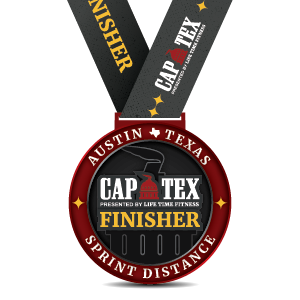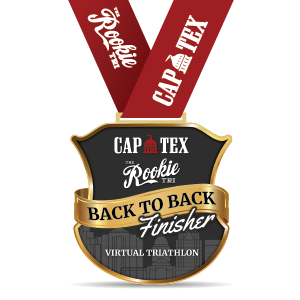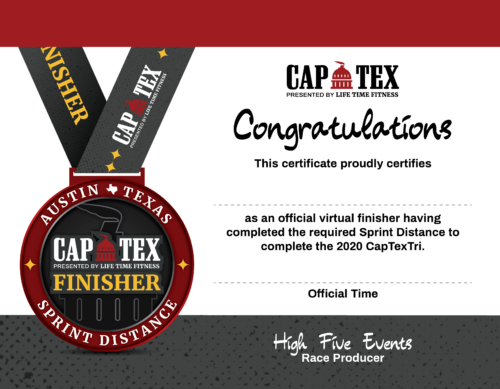Posts
What to Eat and When During a Triathlon
This post was originally published on https://zone3.us/blogs/blog/what-to-eat-and-when-to-eat-during-a-triathlon
By Glen Gore, former pro triathlete and current coach.
If ever there was a hot topic of debate, it comes in the form of triathlon nutrition and more importantly, nutrition intake on race days.
What exactly do you need to eat and drink, and when?
To start this editorial piece, we need to agree that there is no magic formula that will work the same for everyone. Each of us differs in our body mechanics and the way we work with nutritional absorption that it’s almost impossible to pinpoint one clear plan that will work for everyone.
Having said that, you can still use sound advice and at least start on the right track. For us, nutrition is another important discipline in the sport of triathlon. The fastest and most finely tuned sports car in the world will go nowhere fast if there is no fuel in the tank. Similarly no matter how hard you have trained and prepared if you are going to race on zero nutrition, your body (engine) is going to slowly come to a complete stop and falter.
Rule no 1 – don’t neglect your nutritional intake on race days. It’s quite easy to “forget” to drink and eat when you are giving 100% during an all-out race effort. Just know that sooner or later, you will start to run out of energy stores and that is when racing becomes anything but fun.
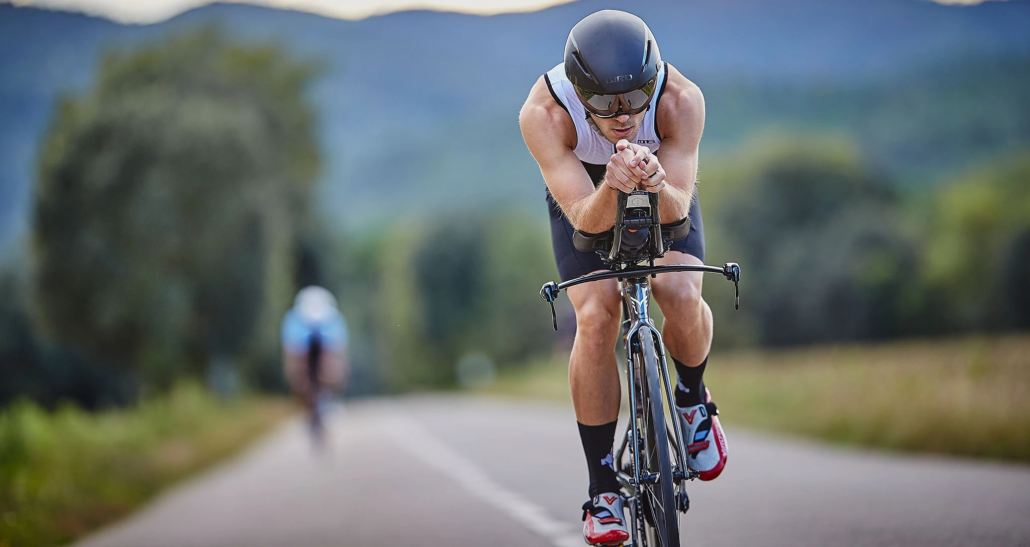
Fuelling is different depending on the distance
A Sprint Distance triathlon race is completely different from an Olympic, Half, or full Ironman distance event. These distances require different amounts of training loads to be fully prepared to take on the challenge. The same rule applies to how you fuel the body during an event that takes less than 60 mins compared to an event that may take up to 17hrs.
Sprint
A sprint race normally lasts anywhere between 52 minutes for the PRO’s up to say 1.5-2hrs for the backmarkers. Most of the time – depending on weather conditions, you can get away with next to nothing in the form of intake over the sprint distance. Some hydration via a small sports bottle and perhaps 1-2 gels for the bike and run should sufficiently see you through the event.
I have often found that my best results over the sprint distance come when I go in “light” – not much food in the tank – that empty feeling but with just enough energy stores from the previous night’s meal or early morning small breakfast to see me through the event.
Hydration is always important – you never want to start any event “thirsty” so make sure the fluid levels are topped up in the form of small sips. A huge intake of fluids just before the start is not a suggested best practice for an optimum result over short distances.
These should be taken as pure guidelines and not as hard-fast rules – these suggestions come from trial and error on the battlefield.
Olympic
When you compete in an event that spans longer than 2hrs, then you need to start looking at a more efficient fueling system.
The Olympic distance event can take anywhere from 2hrs to 3hrs plus – eating and drinking now becomes more important. If you are not fuelling adequately over the 40km cycle, you will feel the burn when you enter the hunt on the 10km run.
Some athletes require less nutritional intake than others while others may require more fluid intake. The best place to learn what your body requires is by trial and error. The more you race over this distance, the more you will learn as to what you require and when.
Half-Distance
When the event time spans over 4hrs in duration right up to 8h30, then you will need a tried and tested method, worked on in training, to see you adequately fuelled in a race that covers a whopping 113km.
The many trained brick sessions will give you a firm indication of what will work for you on race day and what will not. It does become quite expensive when your training sessions have to mimic race days but as the saying goes, practice makes perfect. The more you practice eating and drinking over the longer distances in training, the easier the transition will be from training days to half-distance racing days.
Full IM Distance
So many athletes have “bonked” or “hit the wall” over the full IM distance simply because they ran out of fuel. The body was prepared, the mental side was in place but the “engine” for some reason was neglected.
Firstly consider that a normal day at work would require someone to eat breakfast, lunch, and dinner. Now add in 3.8km of swimming, 180km of biking, and a 42.2km marathon to top it all off, covered in a time that may span at least 17hrs. Now it becomes apparent just how much food and drink is required to keep you moving along at an optimum level.
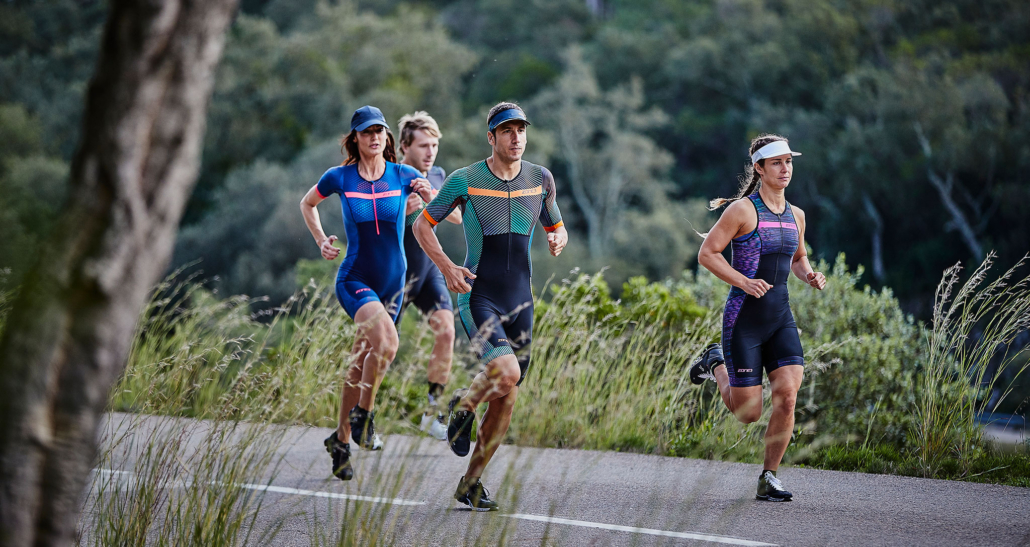
Best Fuelling Tactics during Training
- Find a product that works and more importantly is cost-effective. Just because it’s expensive does not mean it’s better.
- Trial and Error – the brick session will help you develop a suitable war plan for race days. If it works in training, more than likely it will work during the race.
- Make sure you re-fuel within 15-30 minutes after a strenuous workout. As athletes, we often neglect the post-training refueling strategy. Remember you are not only eating for today but you are eating for tomorrow’s training session as well.
Best Fuelling Tactics during Racing
- Eat small bits and drink small sips all the time – especially during the longer races – the reason being to keep the tank on full at all times and not deplete it before you think about replenishing.
- Cut up your energy bars into small bite-size pieces – this is much easier to eat and digest while on the move.
- Get in some solid food sources quickly once you are done with the swim. The longer the duration of the event, the more advisable to start the cycle with something a little more substantial than just a gel.
- Don’t overload your bike with too much nutrition and hydration. This makes that very expensive bike extremely heavy. The bigger races have more than an ample supply of nutrition along the way – make use of it even if you need to stop briefly and take some on-board.
- Don’t start the run in a hurry. T2 over long distances is a time where you need to relax a little and consume some solid nutrition before you head out onto the run. Whatever time you lose in transition you will more than makeup, especially when the run distance is over a full standard marathon.
Common Fuelling Mistakes
- Eating only when hungry – this means it’s already too late. It will take you a long time to get back those lost energy stores, time which you won’t have during the race days.
- Drinking only when thirsty. Once again, this is too late – if you are feeling thirsty you are already on the way to partial dehydration. Keep on sipping water and juice so you never get to feel that thirst.
- Trying new stuff on race day. Stick to what you know and what you have trained on.
- Don’t alter the nutritional plan. What you practiced in training, do the same on race day. Don’t change the formula, there is a good chance it won’t work.
- Drinking too much. This can be a problem worse than drinking too little so take the race weather conditions on the day into account and drink what is normal for you.
Nutrition is important, a successful race plan always has a well thought out nutritional plan that goes along with it, and remember, it takes trial and error to perfect – good luck!
Understanding Lactate Threshold
LACTATE THRESHOLD EXPLAINED
The burning, aching sensation that accompanies intense efforts is all too familiar to athletes. This feeling can also occur when bikers begin to increase their mileage and biking pace. Most athletes have probably heard the terms lactic acid or lactate threshold thrown around by coaches. What do these terms actually mean? Lactate was originally believed to only be produced when the body lacks oxygen. It’s now known you produce lactate even at rest. Far from the cause of fatigue, lactate is shuttled around the body to areas where it is needed as a fuel source such as the heart, muscles, brain, and liver.
During high-intensity training, muscle contractions result in a build-up of metabolites and depletion of glycogen (the fuel inside muscles). This is when lactate is associated with fatigue. At rest and during low-intensity activity, lactate doesn’t build up in the muscles. It is shuttled to areas where it is needed faster than it is produced. Lactate threshold is the point at which the rate of production of lactate is greater than the rate of removal from the muscles. Athletes can only sustain exercise above this threshold for a limited amount of time before exhaustion. Pro tip: this is great information for boosting your mental toughness.
WHY YOU SHOULD KNOW ABOUT THIS
While lactate does not directly cause fatigue, it is still the best metric available for detecting when the body shifts away from mostly aerobic metabolism to rely more heavily on anaerobic metabolism. Anaerobic metabolism can only be sustained for a short period of time before fatigue occurs. Studies show that lactate threshold, or the point at which this transition occurs, is the best predictor of overall endurance performance abilities. If two athletes have the same VO2max, but one athlete can maintain a higher fraction of that VO2max without build up of metabolites (i.e. lactate, hydrogen ions), the athlete with the higher lactate threshold will always win. It’s an objective performance metric that gives invaluable information about your endurance abilities.
Dr. Allen recommends athletes measure their lactate threshold at the beginning of the training season to get a baseline. This can be used to establish training zones unique to their individual physiology, optimize performance, and avoid overtraining. Additionally, he recommends athletes come in for testing once every 3-4 months. This allows the team to monitor training progress and reestablish training zones. As the racing season approaches, the lactate threshold pace can be used to determine exact pacing strategies, no matter the distance. For example, marathoners usually set their race pace right around their lactate threshold. Measuring your lactate threshold gives you the ability to establish your race pace while knowing it’s truly what you’re capable of.
HOW THE MEASUREMENT IS PERFORMED
Lactate threshold can be performed in a clinical setting or in the field depending on the athlete’s preference. Ascension Seton Sports Performance adheres to the most stringent COVID-19 policies. They are also happy to offer the service outdoors if athletes would prefer that. The test involves either running on a treadmill or outdoor track or cycling on a stationary ergometer. As you exercise at increasing intensities their team measures the changes in various physiological parameters. This includes changes in lactate as measured from a drop of blood from the finger or changes in expired gases collected from a mask over your mouth.
ABOUT DR. JAKOB ALLEN
Dr. Allen received his Doctoral training from the nationally ranked University of Texas at Austin. He was an 8x All-American collegiate swimmer at Stanford, American Record holder, NCAA and Pac-10 Champion, and 2x Olympic Trials qualifier. Dr. Allen is now an avid cyclist and triathlete, frequently placing in the top-5 overall amateurs in Central Texas triathlons. He is driven to bring about the greatest potential of all athletes whether you are a weekend warrior or an Olympian.
Dr. Allen currently serves as the Sports Scientist for the Austin Bold FC team in addition to his work in the clinic. He believes that exercise remains one of the best ways to improve every physiological system in the body throughout the lifespan. Whether it’s helping prevent changes in mental acuity or improving muscle function, the benefits of exercise continue to be supported by scientific studies. Dr. Allen specializes in designing exercise training programs for improving muscle and cardiovascular health for aging wellness and masters athlete performance.
6 Best Places to Train in Austin
Here is a list of what we think are the 6 best places to train in Austin. We broke them down by favorite spots to swim, bike, and run. These are great for all levels of triathletes.
Swim
1.Big Stacy
Tucked back in one of Austin’s oldest neighborhoods, this pool has been keeping Austinites of all ages cool and entertained since the 1930s. The best part is it is free to use year-round, with the added bonus of being heated during the winter months. There are a limited number of lanes so be prepared to share or come during non-peak hours.

2.Barton Springs Pool
Constructed in 1940, it has been a summer staple for many years and is known for being Austin’s no. 1 natural pool. It’s easy to see why. The 3-acre, spring-fed pool remains 68°F degrees year-round, making it a refreshing way to shake the heat. It is also a great way to practice open water swimming and swimming in a wetsuit. Get there as early as 5 am on weekdays to swim without the crowds.
Bike
The Southern Walnut Creek Trail is Austin’s first Urban Trail. Not a car in sight! The trail is open for public use and begins at Govalle Park and ends in the vicinity of Johnny Morris Road and Daffen Lane. The trail is approximately 7.3 miles in length and consists of a 10′ wide concrete trail with 2′ shoulders. There are several creek crossings and trailheads on the trail. The lush surroundings can make seeing around corners difficult at times so this is not a great place for a speed workout.
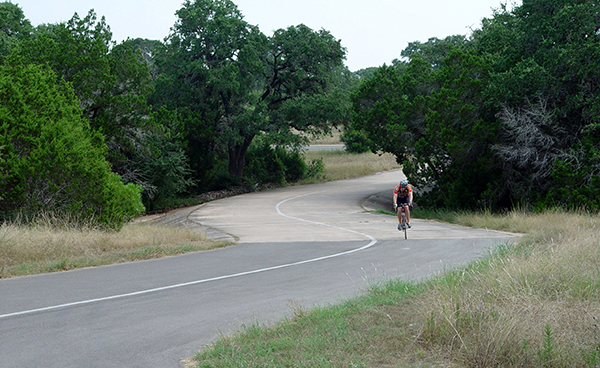 2. Veloway
2. Veloway
The Veloway at Circle C Ranch Metropolitan Park was constructed in the early ’90s and was the first facility of its kind in the United States. The Veloway is a 23’ wide, 3.1 miles (5K) long bicycle tract that traverses the natural terrain. People travel from all over the metropolitan region to cycle here on a daily basis. This path is great because it is for cycling and inline skating only. Still, be on the lookout for the rogue walker or slower cyclist, slower traffic keep to the right and always pass on the left.
Run
 1.Violet Crown
1.Violet Crown
After years of strategic land acquisition and planning, the first six-mile segment is now open and the VCT is on its way to becoming the longest trail of its kind in Central Texas. Once complete, the 30-mile trail will provide a unique recreational experience as it passes through the urban wildlands of the Barton Creek Wilderness Park, the City of Sunset Valley, and eventually into Hays County. Be sure to bring your own water and prepare for off-road bathroom situations as there are no water fountains or bathrooms on the trail.
2. Ann and Roy Butler Hike and Bike Trail at Lady Bird Lake
The go-to spot in Austin. The urban path meanders along the water’s edge and passes by skyscrapers, neighborhoods, ball fields, and cultural attractions. With the completion of the Boardwalk portion of the Trail in June 2014, the trail no offers a full 10-mile loop. The different street crossings at Lamar, 1st Street, and Congress make scenic and convenient crossovers for making this distance you are looking for. With more than 1.5 million visits a year, the 10-mile trail is Austin’s most recognized and popular recreational area.
How to Know the Difference Between Triathlon and Road Bikes
Triathlon Bikes vs. Road Bikes: What’s the Difference?
When it comes to triathlon, a bike is, well, a necessity. How are you supposed to know which bike is best suited for you if you’re new to triathlon or limited on options? In this blog, we’re going to talk about two types of bikes: road bikes and triathlon bikes. Keep reading to understand some key differences between triathlon bikes and road bikes so you can decide which fits your style best for your triathlon journey.
How They’re Different
The most notable difference is the design, or geometry of the frame of each bike. Triathlon bikes have a steeper angle of the seat. Seats on a road bike are positioned at, on average, 78 degrees while the angle on a triathlon bike is closer to 72 degrees. The steeper angle allows the user to travel at a faster rate because you can bend your body down lower which reduces wind resistance. Another huge difference is that a triathlon bike includes aerobars instead of regular handlebars and many models have specially shaped frame tubing and special wheels. These design features are intended to minimize drag and increase speed which is important in triathlon racing.
Triathlon Bikes
Tri bikes allow you to get into a more aerodynamic position by lowering your upper body and bringing your arms in-line with your torso. This is a result of the tilt of the seat in combination with aero bars that cause the cycler to lay lower on the bike with elbows rested. The goal here is to be in the optimal position for a smoother, faster ride. Unlike other handlebar positions, aero bars serve as both handgrips as well as armrests, allowing you to significantly reduce the pressure on your wrists and hands throughout a race or riding for an extended amount of time.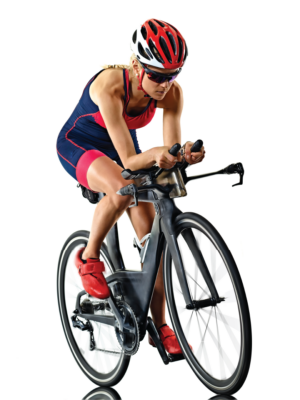
Key Traits of a Tri Bike
- has aerobars
- more aggressive frame geometry
- can be more expensive
- better for speed
- more aerodynamic
Road Bikes
Road bikes are great when aerodynamics are not the top priority. These bikes are typically easy to maneuver during longer rides. Road bike frames are slim and also come with thin tires for riding on the road. The handles on road bikes offer different hand positions. Because of this, most people find road bikes to be more comfortable because you can alter your riding position as needed. For beginner triathletes, we recommended trying a road bike before a triathlon bike.
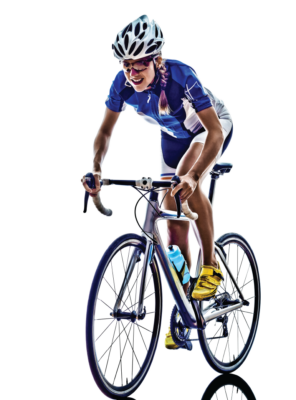
Key Traits of a Road Bike
- more versatile
- less expensive
- lightweight
- can add clip-on aero bars
- easy to customize
Now it’s Time to Make a Decision! Which Bike Will You Choose?
Now that you know the key differences between the types of bikes, take a moment to weigh your options before deciding which bike is better suited for your riding needs. Keep in mind: comfort is key, but you don’t want to compromise speed for comfort or vice versa. It’s all about finding a bike with a balance that works best for your body and your cycling needs. Whichever bike you choose, either will do for the day of your big race. Now, all there’s left to do is choose your bike, grab your shades, and start logging those miles!
Which type of bike do you prefer? Let us know on Facebook or Twitter and tell us what you decide to name your new set of wheels!
USAT-Certified: Why It Matters and How It Benefits You
Benefits to CapTex Tri being USAT-Sanctioned and having a USAT-Certified Race Director
When researching triathlon events, you’ve probably come across the terms USAT-sanctioned and USAT-Certified Race Director. So what exactly do these terms mean and why should you care about the benefits of a USAT Certified race?
USAT-Sanctioned
USAT is an acronym for USA Triathlon, which is the governing body of the sport of triathlon in the United States. Additionally, since triathlon is a sport featured in the Olympic games, USA Triathlon is part of Team USA. Therefore, they must adhere to the rules and guidelines of the US Olympic and Paralympic Committees. When you see the phrase “This is event is sanctioned by USAT” or “This event is USAT-sanctioned” it means that the event organizer has completed a thorough questionnaire regarding how they plan to conduct the event. They have also received approval from the USA Triathlon Events staff. As a potential participant in a triathlon, the term USAT-sanctioned should give you confidence. You are registering for an event that meets minimum standards for safety and fairness.
Participant benefits of a USAT-sanctioned event:
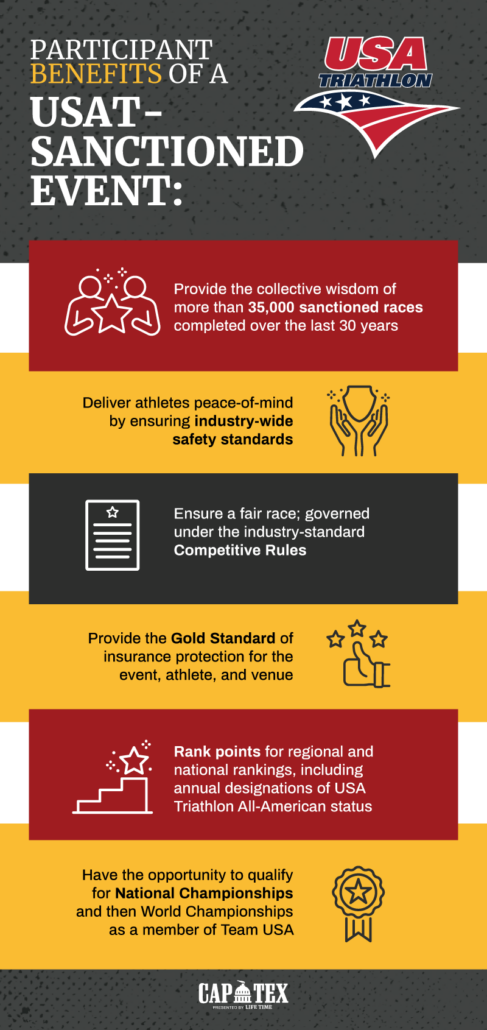 As a participant in a USAT Sanctioned event, you must have a current membership with USA Triathlon. Annual memberships and one-day memberships (purchased per event) are available. Most adult triathlons in the United States are sanctioned by USA Triathlon. This helps the individual event. It also helps keep the national governing body strong so that it can support race directors, growth of the sport initiatives, and Olympic and Paralympic athletes.
As a participant in a USAT Sanctioned event, you must have a current membership with USA Triathlon. Annual memberships and one-day memberships (purchased per event) are available. Most adult triathlons in the United States are sanctioned by USA Triathlon. This helps the individual event. It also helps keep the national governing body strong so that it can support race directors, growth of the sport initiatives, and Olympic and Paralympic athletes.
USAT-Certified Race Director
Additionally, USA Triathlon has created a Race Director Certification program that goes above the standard sanctioning process. Race Directors who choose to become certified go through approximately 16 hours of coursework and complete an exam. They are required to recertify every two years and complete a background check through NCSI and take SafeSport training. The recertification and coursework ensures that the race director remains current in their knowledge and engaged in the triathlon community. There are two levels of Race Director Certifications. Level II is the most difficult to obtain and retain. Only the most qualified race directors reach this level. Dan Carroll of High Five Events was among the first race directors to achieve Level II certification. He has maintained that certification since the program was created in 2007.
Choose USAT Certified for Your Upcoming Tri
So the next time that you register for a triathlon like CapTex Tri, look to see if the event has the benefits of being USA-sanctioned and if it is produced by a Certified Race Director. That way you’ll know you’re safe in good hands and you’re in for an awesome experience!
Swim Faster with Fins
Use fins during your swim training to become faster in the water
Do you want to improve your kick strength, ankle flexibility, body position, and increase your speed in the water? If you’re thinking, duh, try adding fins to some of your swimming workouts for your upcoming tri! With the right amount of training and the right tools, you’ll be on track to improve your swimming abilities for CapTex Tri in no time.
Why you should use fins
Wearing swim fins increases the amount of resistance your muscles experience as you kick, guaranteeing you’ll put your leg muscles to full use. Stronger legs and the additional strength will carry over into normal swimming when you’re not wearing your fins.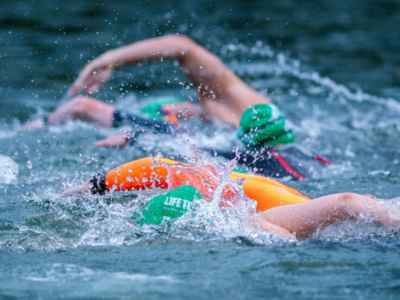
Another benefit of using fins is improved ankle flexibility. This stems from the extra force the fins place on your ankles as you kick. Increased ankle flexibility will result in a more efficient flutter kick through better angles of attack in the water. When you are unable to fully flex your ankles into a streamlined position the ankles remain somewhat bent, catching water instead of propelling the body through it.
Do you have some other new swim equipment? This Rookie Tri blog shows you how to incorporate other swim equipment into your triathlon training.
Technique-focused workout
You’ll want to focus on a slow-motion, over-exaggerated flutter kick. During this workout, focus on slowing down the kick cycle and dramatically increase your range of motion. The over-exaggerated technique allows swimmers to more easily tune into ankle flexion and proper body alignment throughout the kick. As a bonus, this drill is also quite taxing on the legs and core – the increased workload of a large kick also makes for a great strength-building exercise.
2 Rounds
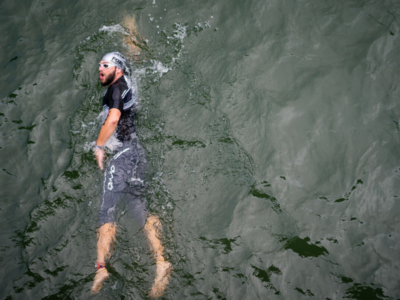 2 x 25 over-exaggerated flutter kick (with kickboard)
2 x 25 over-exaggerated flutter kick (with kickboard)
4 x 25 freestyle, easy
2 x 25 over-exaggerated flutter kick (no kickboard)
4 x 25 freestyle, mid-level effort
2 x 25 over-exaggerated flutter kick (with kickboard)
4 x 25 freestyle, easy
29th Annual CapTex Tri Canceled
Austin’s only downtown triathlon, CapTex Tri, canceled
Thank you for your interest in the 29th annual CapTex Tri presented by Life Time Fitness. We absolutely love Austin’s only downtown triathlon and were ready for another magnificent Memorial Day weekend with triathletes from across the country. We are so thankful to all the participants, volunteers, and event partners who join us every year. Let’s get the bad news out of the way so we can get to the good news.
Unfortunately, as a result of mandates by local/state governments and the recommended CDC guidelines, we are forced to cancel the CapTex Tri scheduled for May 25th. And, unfortunately, postponement is not a viable option based on permitting and venue availability. We know that CapTex Tri being canceled is disappointing and understand the time dedicated to training for your event. Please know that this cancellation was made with the safety of the entire community in mind. We appreciate everyone’s flexibility and understanding.
The Good News
All registered participants can transfer to one of our upcoming triathlons at no cost or request a full refund. Events that are open to transfer include:
- Jack’s Generic Triathlon – August 23, 2020
- Kerrville Triathlon – September 26 – 27, 2020
- 2021 Rookie Triathlon – May 2, 2021
- 2021 CapTex Tri – May 31, 2021
Transfer
If the event you transfer to is also canceled we will offer transfers/refunds via a similar process. Participants who wish to upgrade distances at Kerrville Tri or 2021 CapTex Tri will need to pay the difference in registration for that distance. That request can only be filled after the transfer to the original distance is complete.
Refund
All merchandise and USAT one-day purchases will be refunded for the event, regardless of transfer or refund request. If you select to transfer you will receive a merchandise refund notice from EventDog.com before you receive instructions to transfer your registration to another event. To process everyone we need all responses no later than Friday, May 29, 2020. Please note the refund and transfer process will take up to two weeks for us to complete.
Participants may request a full refund if they do not wish to transfer registration to any of the above events. Current virtual participants will be refunded and are invited to join in the new FREE virtual event that will launch next week. We ask that all participants submit their request by Friday, May 10th. Anyone who does not fill out the request form will be automatically transferred to next year’s CapTex Tri at no cost.
Every participant should receive an email with details on how to complete this process. If you didn’t please check your spam folder. If you still can’t find it, email info@captextri.com and we are happy to resend you the link.
More Good News: Free Virtual CapTex for Everyone!
We will also offer a free virtual triathlon/duathlon to all participants and the entire triathlon community. There will be fun incentives, free downloadable personalized bibs, and finisher certificates. The free virtual event will launch next week, so keep an eye on your inbox!
We look forward to seeing you soon and will continue to post blogs and social media on triathlon, training, and everything you need for a healthy and happy lifestyle.
Austin Premier Virtual Triathlon!
Race CapTex Tri from anywhere in the world!
We know how hard all of our participants have trained for the CapTex Tri presented by Life Time Fitness to not be able to take to the course this coming Memorial Day Weekend. We think all your efforts still deserve some acknowledgment and praise. It’s time to finish what you started and show off your skills by completing the Free 2020 Virtual CapTex Tri. This event is open to the public so be sure to challenge your friends and family to join you!

Completing a virtual triathlon is great motivation to accomplish your fitness goals and commit to healthy living habits! And, besides feeling good about yourself, you will also receive a downloadable personalized bib, finisher certificate, and digital finisher medal.
Participants will have the option to complete either the sprint or olympic distance events. If you do not have access to a place to swim you can complete the event as a duathlon. Participants will track their distance and time using their watch or a smartphone app.
Sprint Tri: 750 meter swim, 12.3 mile bike, 3.1 mile run
Sprint Duathlon: 2 mile run, 12.3 mile bike, 3.1 mile run
Olympic Tri: 1500 meter swim, 24.3 mile bike, 6.2 mile run
Olympic Duathlon: 4 mile run, 24.3 mile bike, 6.2 mile run
Registration is open for the Free CapTex Tri from April 29th through Monday, May 25th. You can submit your results through May 29th, the Friday after registration closes. The official results page with finisher certificates will be updated on April 28th, May 12th, and May 29th.
Want to take the challenge to the next level? Complete the Rookie Tri Virtual and the CapTex Virtual Triathlons by their respective dates and you will earn this limited edition Back-t0-Back digital finisher medal! Registration is open for the Free 2020 Virtual Rookie Triathlon from through May 3rd.
How to Participate
With this virtual tri, you can do it all at once or can complete each segment of the triathlon on your own schedule. For example, you can do part of the swim on Monday, part of the run on Wednesday and part of the bike on Friday. You can do each part in a location and time that’s convenient for you. Even if you weren’t planning on joining us for CapTex Tri, now is the chance to put yourself to the test at the pace you’re comfortable with.
- Register for the event on EventDog.com.
- Follow the link in the confirmation email to personalize & download your bib.
- Document your journey with a before and after photo. Optional but totally encouraged!
- Swim (Run), Bike & Run!
- Keep track of your time with your watch or a smartphone app like MapMyFitness. Complete your distances indoors or outdoors during the time frame.
- Post your results before May 29, 2020, to the link in your confirmation email.
- Connect with us on Social! Tag your photos on Instagram & Twitter with #RookieTriVirtual


